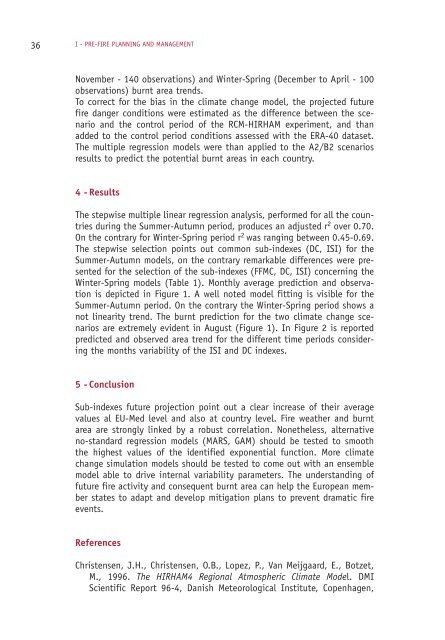7th Workshop on Forest Fire Management - EARSeL, European ...
7th Workshop on Forest Fire Management - EARSeL, European ...
7th Workshop on Forest Fire Management - EARSeL, European ...
You also want an ePaper? Increase the reach of your titles
YUMPU automatically turns print PDFs into web optimized ePapers that Google loves.
36<br />
I - PRE-FIRE PLANNING AND MANAGEMENT<br />
November - 140 observati<strong>on</strong>s) and Winter-Spring (December to April - 100<br />
observati<strong>on</strong>s) burnt area trends.<br />
To correct for the bias in the climate change model, the projected future<br />
fire danger c<strong>on</strong>diti<strong>on</strong>s were estimated as the difference between the scenario<br />
and the c<strong>on</strong>trol period of the RCM-HIRHAM experiment, and than<br />
added to the c<strong>on</strong>trol period c<strong>on</strong>diti<strong>on</strong>s assessed with the ERA-40 dataset.<br />
The multiple regressi<strong>on</strong> models were than applied to the A2/B2 scenarios<br />
results to predict the potential burnt areas in each country.<br />
4 - Results<br />
The stepwise multiple linear regressi<strong>on</strong> analysis, performed for all the countries<br />
during the Summer-Autumn period, produces an adjusted r 2 over 0.70.<br />
On the c<strong>on</strong>trary for Winter-Spring period r 2 was ranging between 0.45-0.69.<br />
The stepwise selecti<strong>on</strong> points out comm<strong>on</strong> sub-indexes (DC, ISI) for the<br />
Summer-Autumn models, <strong>on</strong> the c<strong>on</strong>trary remarkable differences were presented<br />
for the selecti<strong>on</strong> of the sub-indexes (FFMC, DC, ISI) c<strong>on</strong>cerning the<br />
Winter-Spring models (Table 1). M<strong>on</strong>thly average predicti<strong>on</strong> and observati<strong>on</strong><br />
is depicted in Figure 1. A well noted model fitting is visible for the<br />
Summer-Autumn period. On the c<strong>on</strong>trary the Winter-Spring period shows a<br />
not linearity trend. The burnt predicti<strong>on</strong> for the two climate change scenarios<br />
are extremely evident in August (Figure 1). In Figure 2 is reported<br />
predicted and observed area trend for the different time periods c<strong>on</strong>sidering<br />
the m<strong>on</strong>ths variability of the ISI and DC indexes.<br />
5 - C<strong>on</strong>clusi<strong>on</strong><br />
Sub-indexes future projecti<strong>on</strong> point out a clear increase of their average<br />
values al EU-Med level and also at country level. <strong>Fire</strong> weather and burnt<br />
area are str<strong>on</strong>gly linked by a robust correlati<strong>on</strong>. N<strong>on</strong>etheless, alternative<br />
no-standard regressi<strong>on</strong> models (MARS, GAM) should be tested to smooth<br />
the highest values of the identified exp<strong>on</strong>ential functi<strong>on</strong>. More climate<br />
change simulati<strong>on</strong> models should be tested to come out with an ensemble<br />
model able to drive internal variability parameters. The understanding of<br />
future fire activity and c<strong>on</strong>sequent burnt area can help the <strong>European</strong> member<br />
states to adapt and develop mitigati<strong>on</strong> plans to prevent dramatic fire<br />
events.<br />
References<br />
Christensen, J.H., Christensen, O.B., Lopez, P., Van Meijgaard, E., Botzet,<br />
M., 1996. The HIRHAM4 Regi<strong>on</strong>al Atmospheric Climate Model. DMI<br />
Scientific Report 96-4, Danish Meteorological Institute, Copenhagen,
















